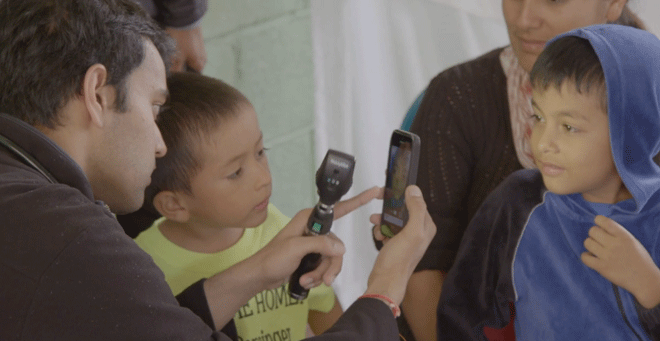 |
|
School of Medicine student Nitin Shrivastava is working with an international consortium of researchers and clinicians in Guatemala to test and disseminate use of a smartphone app that can increase early diagnosis of a rare childhood cancer called retinoblastoma by detecting leukocoria. Commonly known as “white eye,”’ leukocoria is a reflection from the back of the eyeball that can indicate the presence of tumors before a child experiences symptoms.
“The time window we have is critical in that you can really change the options for the child with retinoblastoma if you intervene early,” said Shrivastava, who has finished his third year of medical school and will be earning a master’s in public health at Harvard University before returning to complete his fourth year. “This app is a brilliant way in which we are starting to use portable technology in medicine to change patients’ lives.”
In the United States, retinoblastoma has a 94 percent five-year cure rate because screening for leukocoria with an ophthalmoscope is a routine part of well-child visits for children between birth and age 5, and early detection prior to metastasis permits curative treatment. But in Guatemala, where most cases have metastasized by the time a child is diagnosed and referred for treatment, the five-year survival rate is less than 30 percent.
The Computer Assisted Detection of Leukocoria (CRADLE) smartphone app, also known as the white eye detector app, offers a low-cost, easy-to-use technology that allows for rapid leukocoria detection in resource-limited countries around the globe where ophthalmoscopes are hard to come by.
CRADLE was developed by an American engineer whose son’s life-threatening case of retinoblastoma was not diagnosed until he was 3 months old, even though photographs taken of him beginning when he was 12 days old showed the telltale white eye that indicates the highly aggressive disease may be present. By activating the smartphone’s LED and video camera, CRADLE converts a smartphone into a computer-assisted ophthalmoscope; the app then analyzes each video frame as it is recorded in real time, highlighting images of eyes that show signs of leukocoria with red boxes.
Already popular with parents in developed countries, including Germany and the United States, CRADLE is now being considered as an ophthalmoscope alternative in underdeveloped countries. Guatemala is an ideal site for testing the app because, while remote rural regions are medically underserved, Guatemala City is home to Unidad Nacional de Oncologia Pediatrica, a world-class pediatric cancer hospital with the resources to treat children diagnosed with retinoblastoma.
Shrivastava earned his undergraduate degree from Tufts University, where he studied biochemistry and community health, and made multiple trips to Guatemala to volunteer on community health projects with Timmy Global Health, a non-governmental organization where he was also employed for a year following graduation. But he didn’t believe he could combine his interests in pediatric oncology and global health until he joined the Global Health Pathway at UMass Medical School. With his award of a UMMS Office of Global Health Travel Grant, Shrivastava joined a network of global oncology collaborators, including researchers at Boston’s Dana Farber Cancer Institute, St. Jude Children’s Research Hospital in Memphis and Unidad Nacional de Oncología Pediátrica (UNOP), St. Jude’s twin pediatric cancer hospital in Guatemala City.
His initial project was pilot-testing an early detection initiative by developing partnerships between UNOP and community-based primary care providers. The pilot developed training materials to advocate for screening every pediatric patient between birth and age 5 for early detection of retinoblastoma, whether with an ophthalmoscope or the CRADLE smartphone app. It also explored ways to streamline the country’s slow referral system to facilitate prompt referral of children with white eye for immediate diagnosis and treatment at UNOP.
Since the introduction of the app into the initiative during the past year, the research has expanded to assess its effectiveness in helping community-based primary care clinicians more easily and cost-effectively incorporate white eye detection into their practices.
“We hope to show that this app is as good as or better than ophthalmoscope for detection of leukocoria,” said Shrivastava. “I am focusing on understanding how the app can have a practical impact on-the-ground in resource-limited environments such as rural communities and health centers in Guatemala. Smartphones are becoming more accessible and more affordable for physicians worldwide, and if we can show that an app such as this one has an appropriate accuracy to detect early signs of retinoblastoma, it could be very useful in a setting where ophthalmoscopes are not available.”
Shrivastava was featured in “Clear As Day: the Free Tech That's Saving the Sight & Lives of Guatemala's Children,” a video that won honorable mention in the Consortium of Universities for Global Health CUGH-Pulitzer 2016 Global Health Video Competition.
“I want global health to be an integral part of my career and I see myself going into pediatric oncology,” he said. “Working with children and families going through this kind of experience, being a part of it, having the responsibility to hopefully make things a little clearer for them, brings me true happiness. Having this opportunity and these mentors has been a dream come true for me.”
Related story on UMassMedNow:
From compassionate students to caregivers, newest GHHS members inducted